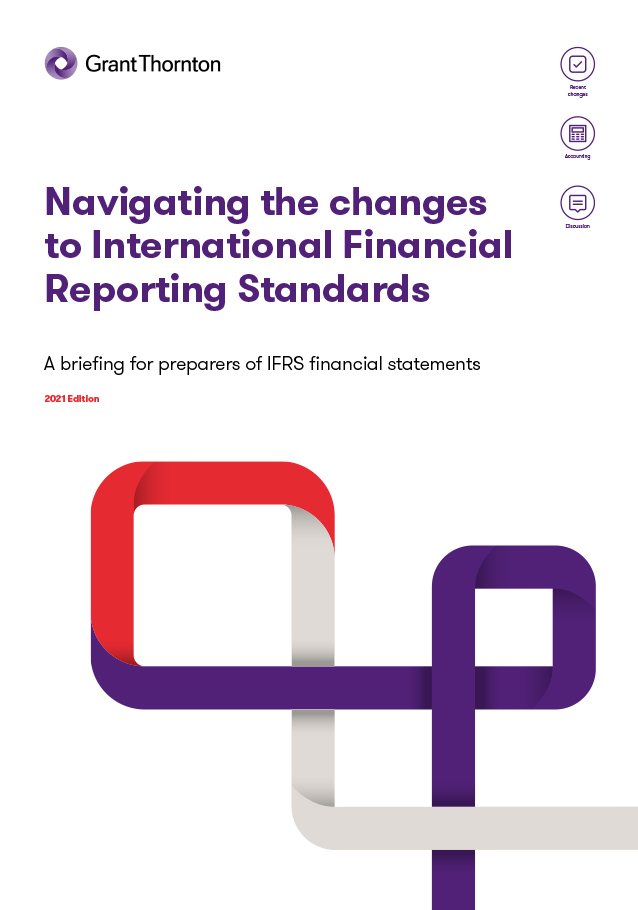-
Corporate Tax
We are your problem solvers for corporate tax issues
-
Restructuring, Mergers & Acquisition
Expertise and creativity for the perfect structure
-
International Tax
We are here, whenever our clients require our assistance
-
Transfer pricing
We are your experts for an optimal transfer pricing structure
-
Indirect Tax & Customs
We take care of your indirect taxes so you can take care of your business
-
Private Wealth
We are your competent partner in the field of Private Wealth Tax Services
-
Real Estate Tax
We are a valuable partner at every stage of your property's life
-
Global Mobility Services
Local roots and global networking as a secret for successful assignment management
-
Advisor for Advisor
As advisors for advisors, we support in complex situations
-
Accounting & Tax Compliance Services
Grant Thornton Austria - Your Partner for Experts for Accounting & Tax Compliance Services. In an evolving regulatory landscape, efficient accounting, tax compliance, and financial statement preparation processes are crucial for maintaining an accurate and up-to-date view of your company’s financial position while ensuring compliance with all legal requirements. We provide tailored solutions that not only save your time and resources but also ensure compliance with complex regulations. Our experts are here to support you, allowing you to focus on your core business.
-
Payroll & People Advisory Services
Ensuring Compliance, Efficiency, and Strategic HR Solutions In an evolving legal landscape, it is crucial for companies of all sizes to have efficient and legally compliant payroll accounting systems. The ever-changing regulations and increasing complexity make this an ongoing challenge. At Grant Thornton Austria, we provide comprehensive, precise payroll processing as part of our Payroll & People Advisory Services. Additionally, we offer customized advisory services to help clients optimise their HR strategy, improve operational efficiency, and minimize potential risks.
-
Tax Controversy Services
Your Partner when it matters most! In increasingly complex environment and considering frequent changes in tax regulations, businesses are facing intensified scrutiny from tax authorities. This has resulted in a significant rise of complex tax audits, investigations and potential disputes. Our Tax Controversy Services are tailored to help you navigate these challenges proactively and effectively. Our experts will guide you through all stages of tax proceedings, ensuring robust defence of your position and advising you on preventive measures to minimize the risk of future tax disputes.
-
Tax Technology Services
Your digital partner for an efficient future! In an increasingly digitalised business world, companies must constantly look for optimisations and adjustments to ensure their long-term success. In order to best prepare for the future and to achieve efficiency increases and process optimisations in the digital area, the experts at Grant Thornton Austria are at your side as a reliable partner as part of our Tax Technology Services.
-
Audit of annual and consolidated financial statements
We place particular emphasis on customized solutions and international service and adapt our services to your needs.
-
Assurance related advisory services
Assurance related advisory services are based on the knowledge and expertise that are the staff of life of our auditors.
-
Global audit technology
We apply our global audit methodology through an integrated set of software tools known as the Voyager suite.
-
Accounting related consulting
Accounting in accordance with UGB, US-GAAP or IFRS is in constant motion. The integration of new regulations into their own accounting systems poses special challenges for companies.
-
Valuation
Valuations are a core competence of Grant Thornton Austria. As auditors and tax advisors we combine profound know-how with our practical experience to offer you customized solutions for your valuation assignment. Our industry expertise is based on years of services to our clients, including listed companies as well as owner-managed companies with an international focus. We advise on valuation matters related to arbitration and provide expert opinions.
-
Forensic Services
When it comes to risks in business, our experts are on hand. We support you not only in suspicious cases or in disputes, but also develop suitable strategies in the area of prevention to avoid serious cases as far as possible. Our Cyber Security team helps you to keep your networks and applications secure and is quickly on hand in the event of a security leak.
-
Cyber Security
Cyber incidents, IT system failures, the resulting business interruptions and the loss of critical data are one of the greatest business risks for companies. Recent cases underline the need for strategic protection and awareness of the issue and require a holistic approach and technical expertise that takes into account all legislative, regulatory and technical aspects of cyber security to protect companies against the daily increase in cybercrime incidents.
-
Sustainability Services
Sustainability is no longer a trend, but the only way to create a future worth living. Our experts will support you in successfully developing your sustainability strategy and preparing your sustainability reporting in compliance with regulations.
-
Transaction Support
We can support you throughout the transaction process – helping achieve the best possible outcome at the point of the transaction and in the longer term.
-
Merger & Acquisition
Companies start new activities and separate from old ones, cooperate and merge. Markets and competitive conditions are subject to constant and increasingly rapid change. As a result, existing business models are changing. Some companies have to restructure and reorganize. But new business opportunities also open up.
-
Restructuring & Going Concern Forecast
Restructuring & Going Concern Forecast: Bundled services for your strategic, operational and financial decisions offer the right answers for companies, banks, shareholders and investors.
-
Internal Audit
Internal Audit helps companies and organisations to achieve their goals by analysing and evaluating the effectiveness of risk management, controls and management and monitoring processes. Internal Audit focuses on independent and objective audit (assurance) and consulting services that improve the value creation and business activities of your company.
-
Expert dispute resolution & advisory
Grant Thornton Austria offers comprehensive services in the field of business-oriented expert services with a broad range of competencies from banking to communication. The core activity of experts is the objective recording of findings and the preparation of expert opinions - regardless of all external circumstances. Our experts Gottwald Kranebitter and Georg H. Jeitler, as sworn and court-certified experts, ensure that the highest professional standards and the principle of objectivity are observed.
-
Blockchain and Crypto-Asset
Blockchain as a carrier technology for crypto currencies and smart contracts, among other things, is becoming increasingly important. Grant Thornton Austria offers comprehensive audit and confirmation services for block chain technologies and business models.
-
International Project Coordination
Our International Engagement Management team is your central point of contact for international projects in all our service lines. We take care of operational project management for you and act as a central point of contact and coordination for your projects. We support companies that start international projects from Austria as well as companies from abroad that want to gain a foothold in Austria or use Austria as a hub for their international projects, especially in the DACH (Germany, Austria and Switzerland) and CEE region.
-
International Desks
As a member of the Grant Thornton network, we guarantee direct access to resources from our worldwide circle of partners. This global connection enables us to seamlessly integrate highly qualified specialists and industry experts from different countries around the world into our teams. Through our broad perspective and diverse expertise, we ensure that we can optimally meet the individual requirements of our clients in an increasingly globalised economy.

The 2021 edition of the publication has been updated for changes to International Financial Reporting Standards (IFRS) that were published between 1 January 2020 and 31 December 2020.
The publication now covers 31 March 2020, 30 June 2020, 30 September 2020, 31 December 2020 and 31 March 2021 financial year ends.
Identifying the changes that will affect you
EFFECTIVE DATES OF NEW STANDARDS
-
IFRS 16: Leases - 1 January 2019
-
IFRS 9: Payment features with negative compensation - 1 January 2019
-
IAS 28: Long-term interests in associates and joint ventures - 1 January 2019
-
IFRIC 23: Uncertainty over income tax treatments - 1 January 2019
-
IAS 12, IAS 23, IFRS 3, IFRS 11: Annual improvements to IFRS 2015-17 cycle - 1 January 2019
-
IAS 19: Plan amendment, curtailment or settlement - 1 January 2019
-
Various: Amendments to references to the conceptual framework in IFRS Standards - 1 January 2020
-
IFRS 3: Definition of a business - 1 January 2020
-
IAS 1, IAS 8: Definition of material - 1 January 2020
-
IFRS 9, IAS 39, IFRS 7: Interest rate benchmark reform - 1 January 2020
-
IFRS 16: COVID-19 related rent concessions - 1 June 2020
-
Various interest rate benchmark reform phase 2 - 1 January 2021
-
IFRS 3: References to the Conceptual Framework - 1 January 2022
-
IAS 37: Onerous contracts – cost of fulfilling a contract - 1 January 2022
-
IFRS 1, IFRS 9, IFRS 16, IAS 41: Annual improvements to IFRS Standards 2018-20 cycle - 1 January 2022
-
IFRS 17: Insurance contracts - 1 January 2023
-
IFRS 4: Extension of the temporary exemption from applying IFRS 9 - 1 January 2023
-
IAS 1: Classification of liabilities as current or non-current - 1 January 2023
The effective dates table has been colour coded within the document to help entities planning for a specific financial reporting year-end and identifies:
- changes mandatorily effective for the first time
- changes not yet effective
- changes already in effect.
Where a change is not yet mandatorily effective for a particular year-end, it may still be possible for an entity to adopt it early (depending on local legislation and the
requirements of the particular change in concern).
Where a change has been made but an entity is yet to apply it, certain disclosures are required to be made under IAS 8 ‘Accounting Policies, Changes in Accounting Estimates and Errors’. Disclosures required include the fact that the new or amended Standard or Interpretation has been issued but it has not yet been applied and known or reasonably estimable information relevant to assessing its possible impact on the financial statements in the period of initial application.
Identifying the commercial significance of the changes in the publication
For each change covered in the publication, we have included a box on its commercial implications. These sections focus on two questions:
- how many entities will be affected?
- what will be the impact on affected entities?
A traffic light system in the publication indicates our assessment of the answers to these questions
If you would like help to navigate the IFRS Standards please speak to our experts Christoph Zimmel and Rita Gugl.


